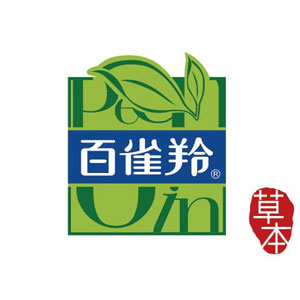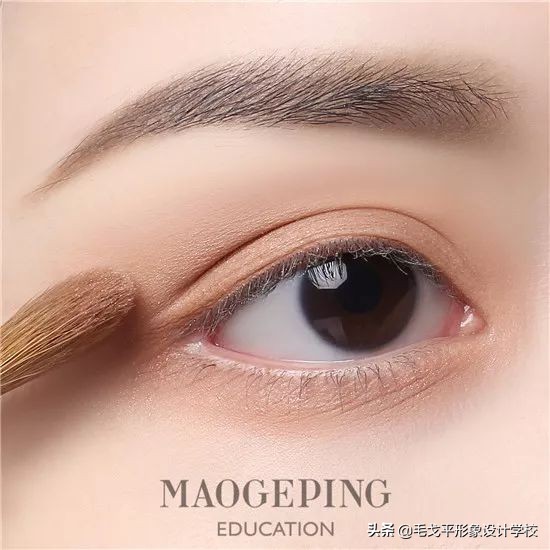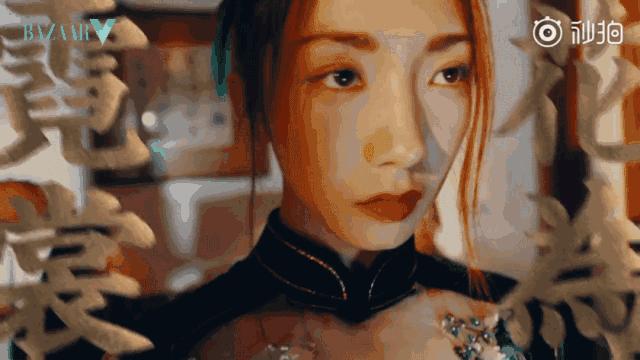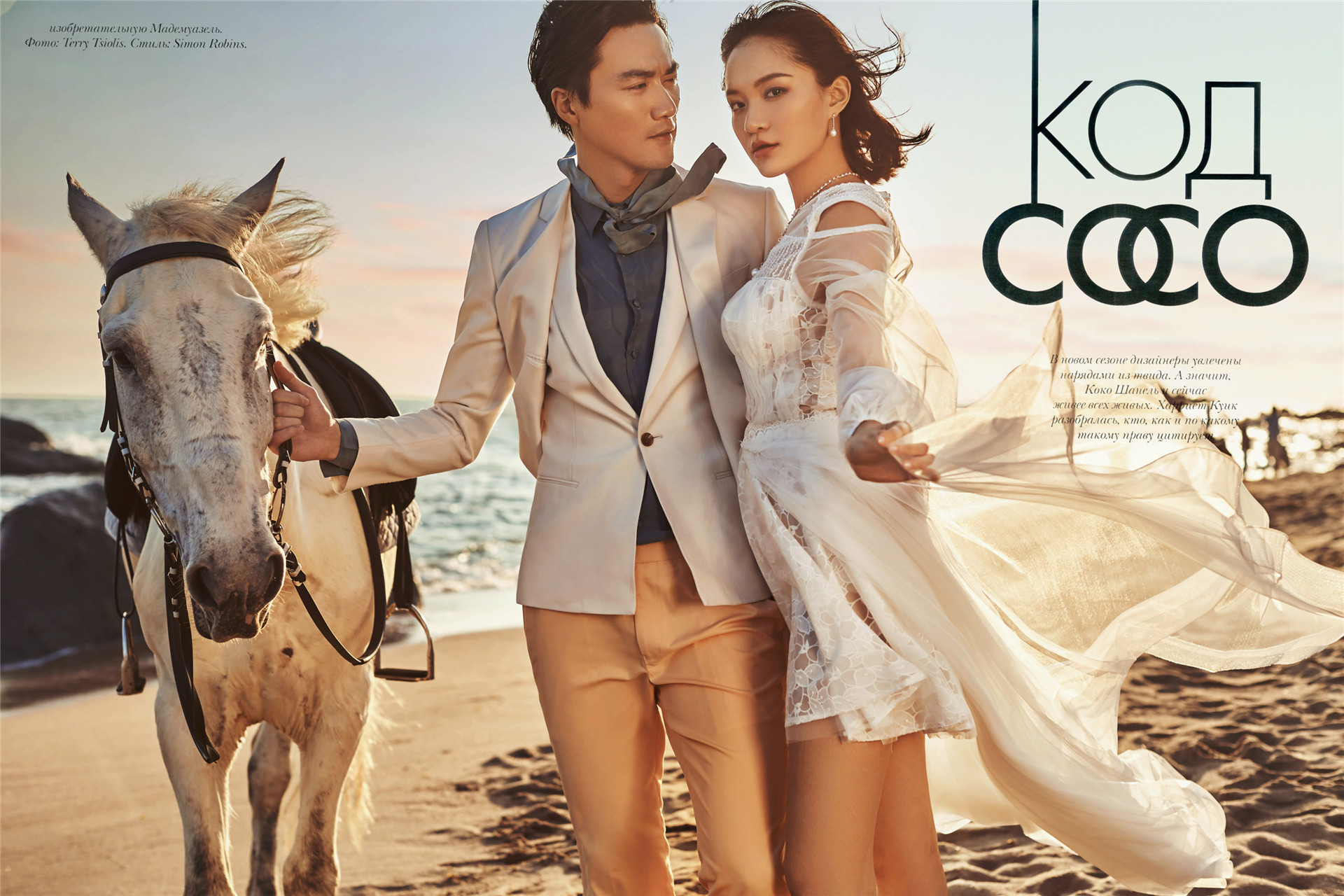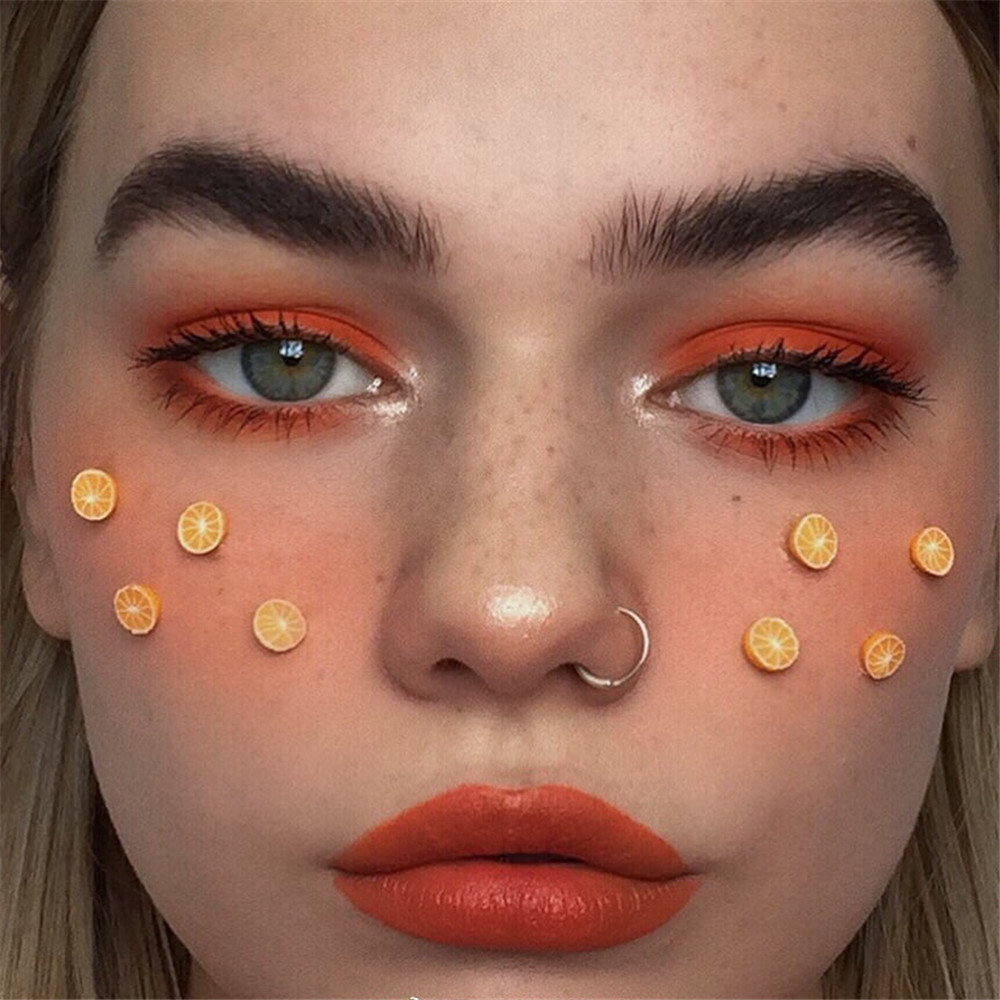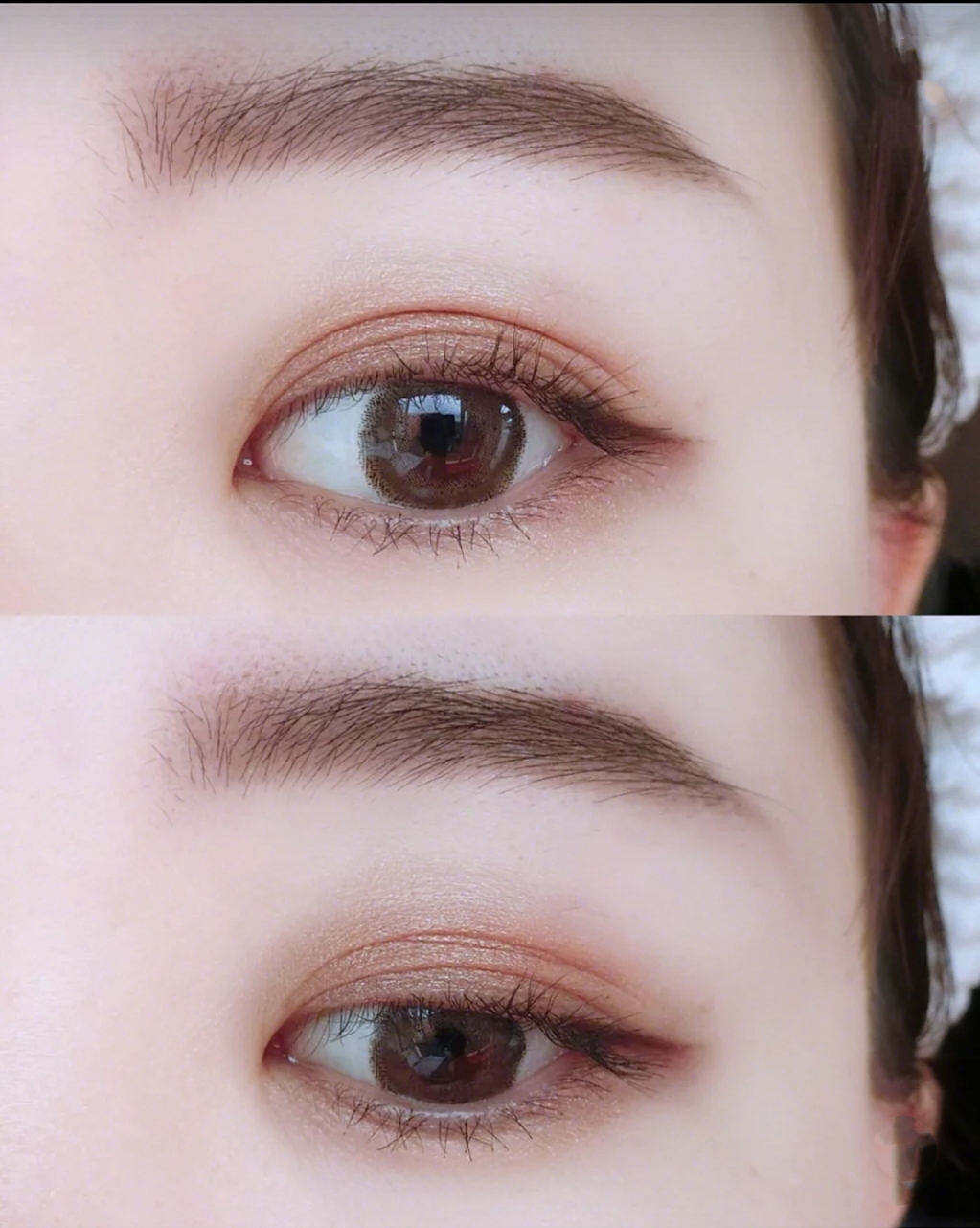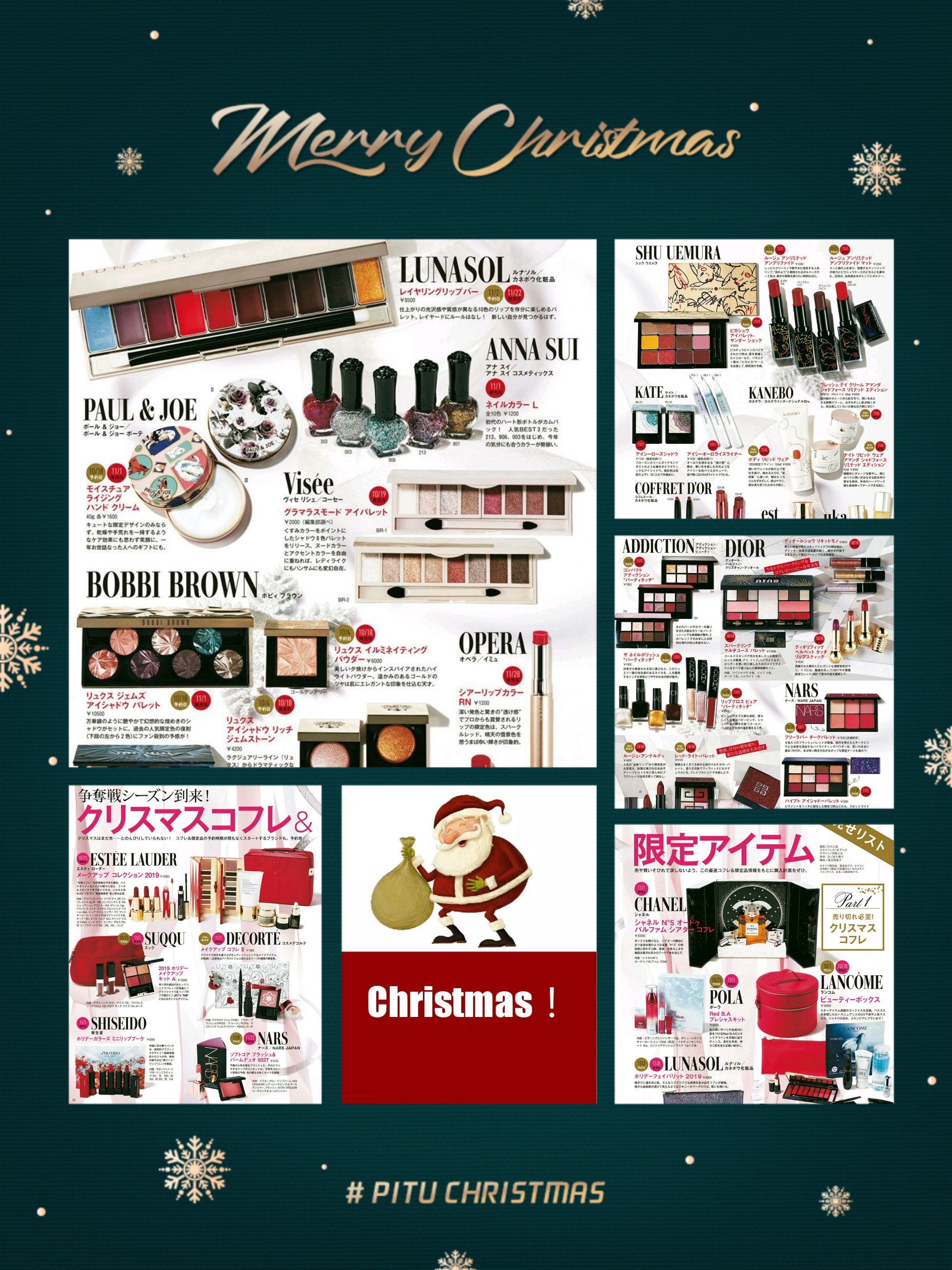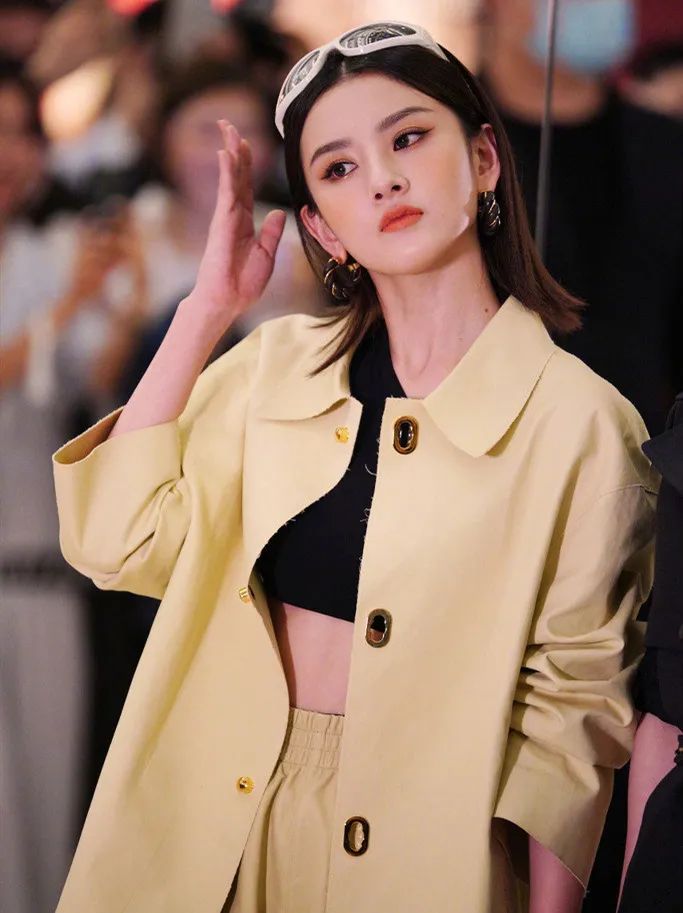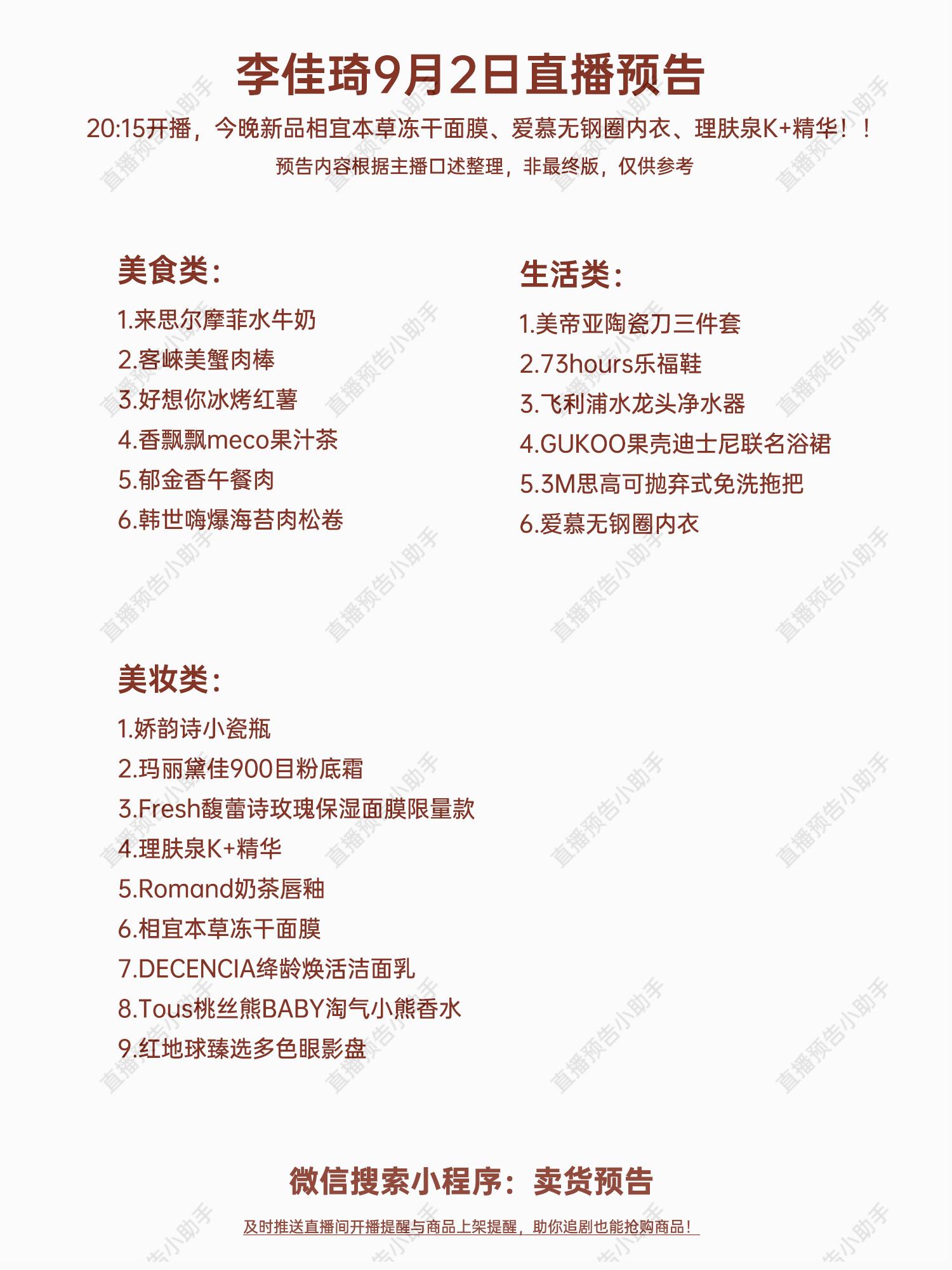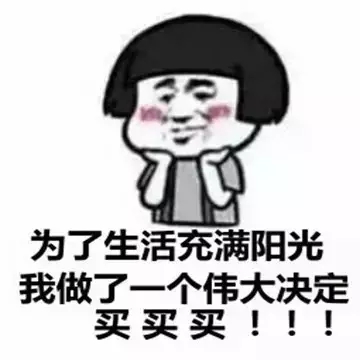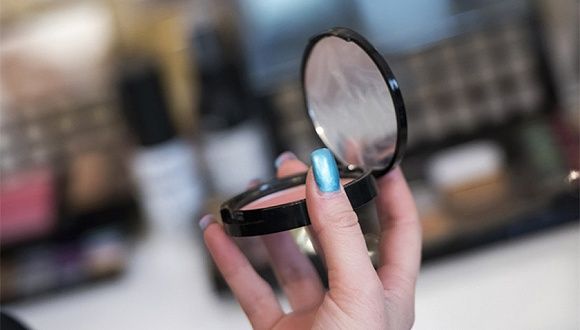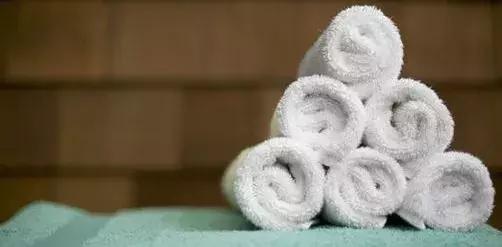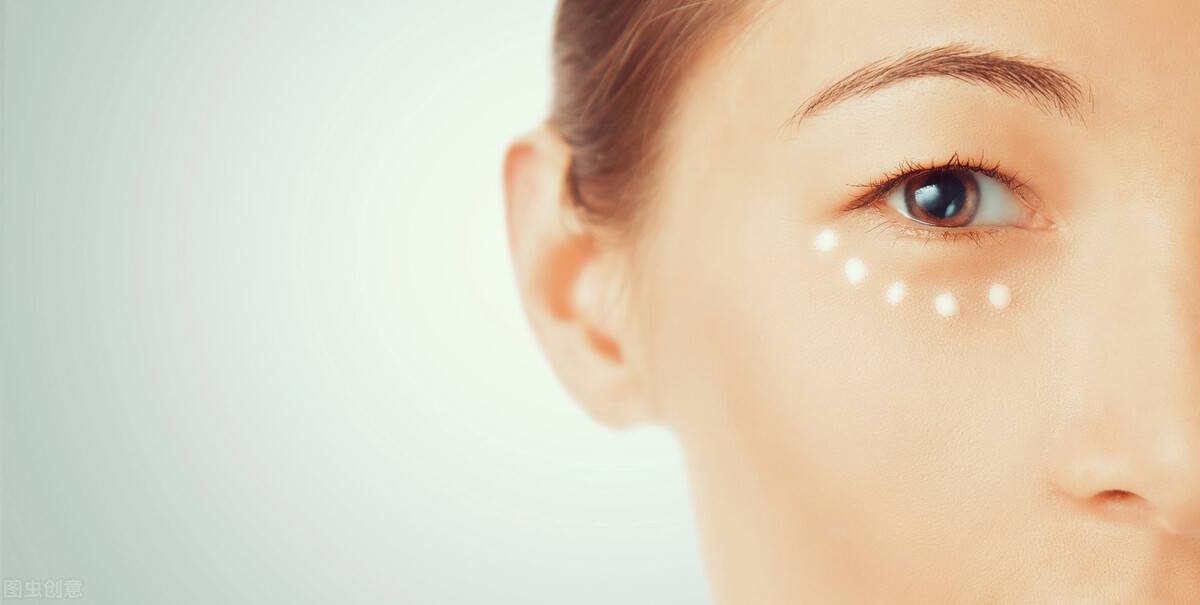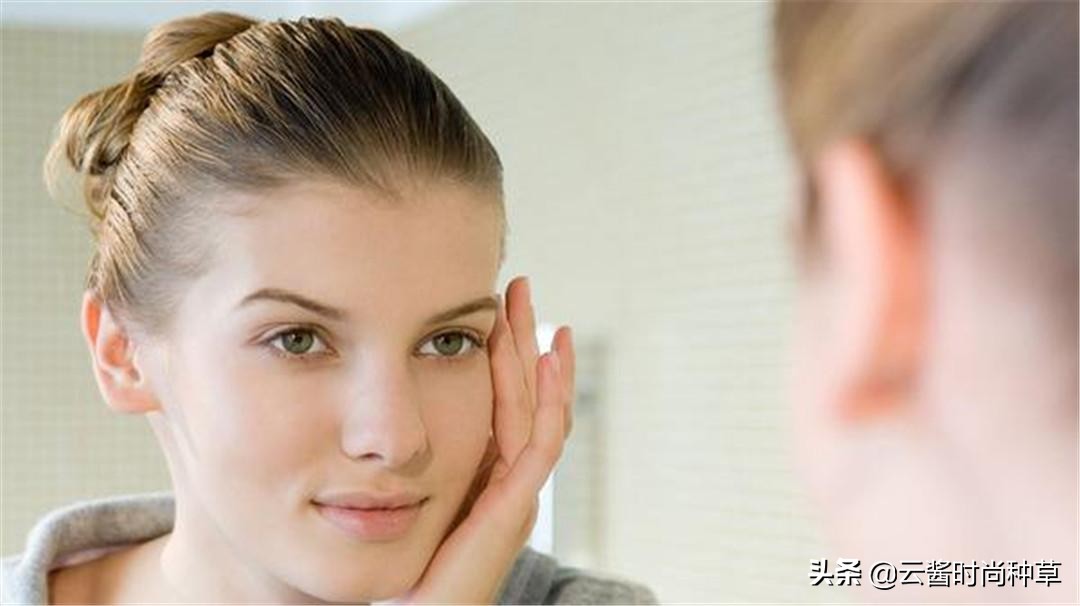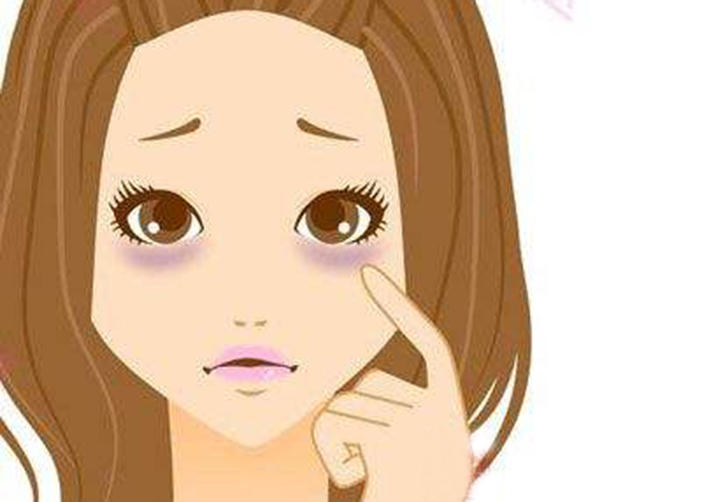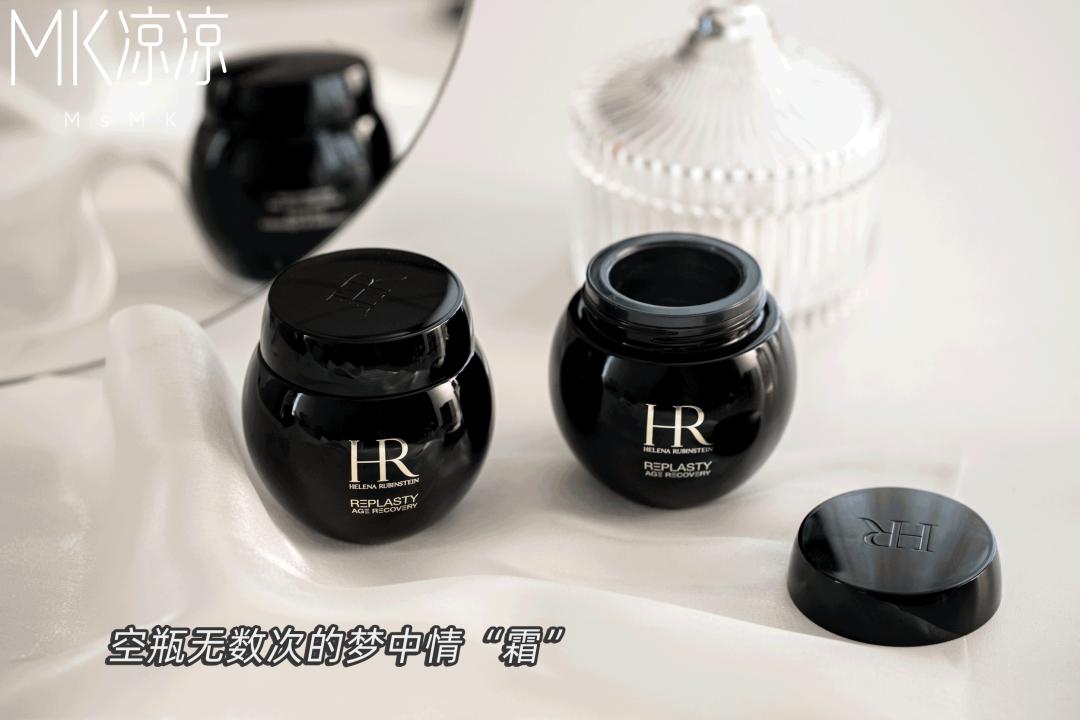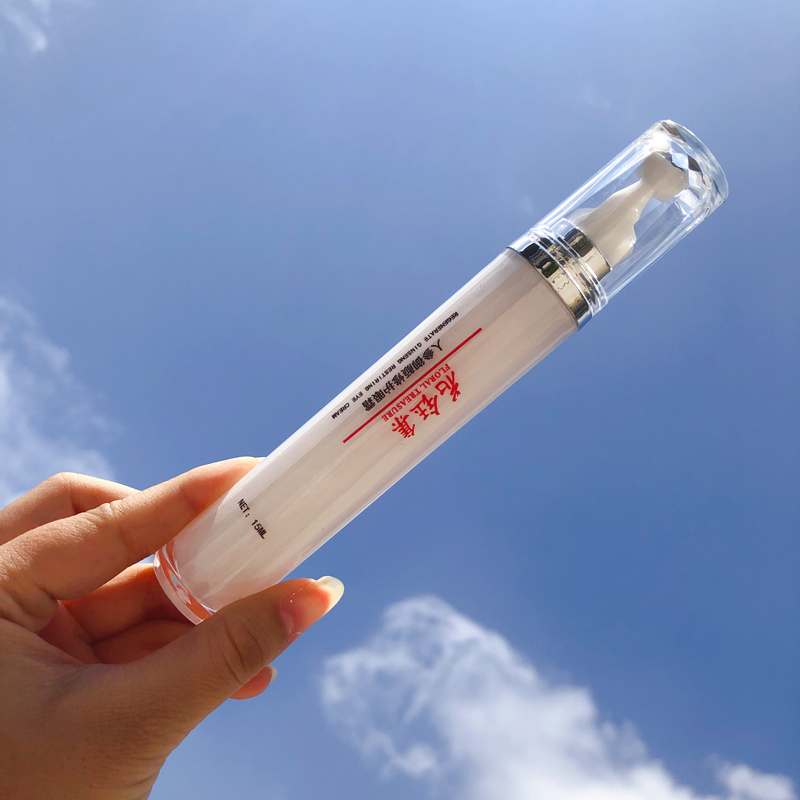寿山石,我国传统的“四大印章石”之一。田黄石是寿山石系中的瑰宝,素有“万石中之王”尊号。在人类漫长的历史长河中有关于寿山石的记载,最早可追溯到距今约1500年的南朝时期,如在墓葬中出土的石俑。寿山石在宋代开始大量开采,元末开始刻印,并因此有寿山石印钮艺术的产生,一直到明末清初时期才有田黄记载,当时被视为皇家珍秘之物。田黄石色泽温润可爱,肌理细密,自明清以来就被印人视为“印石之王”。数百年来田黄石极受藏家至爱,正如俗语所说:“黄金易得,田黄难求”。
Shoushan stone is one of the four traditional seal stones in China. Tianhuangshi is a gem of Shoushan stone system, known as king of ten thousand stones. There are records about Shoushan stone in the long history of mankind, which can be traced back to the Southern Dynasty about 1500 years ago, such as the stone figurines unearthed in the tombs. Shoushan Stone began to be mined in large quantities in Song Dynasty and engraved at the end of Yuan Dynasty. Therefore, the production of Shoushan Stone Button printing art was not recorded until the late Ming Dynasty and the early Qing Dynasty, when it was regarded as a royal treasure. Tianhuang stone is warm and lovely in color and fine in texture. It has been regarded as the king of stone printing by the Indians since the Ming and Qing Dynasties. For hundreds of years, Tianhuang stone has been loved by collectors. As the saying goes, gold is easy to get, but Tianhuang is hard to get..

早在一千多年前,我国已有人开始采集田黄石,到了明清两代田黄石更是盛名于世,以其“灿如金、润如玉、凝如脂”而备受皇家、达官显贵及文人雅士追捧。相传清初时期,田黄石被作为贡品上呈皇宫,以换取皇帝的赏识,特别是传说中乾隆皇帝每年元旦祭天,神案上都少不了一方上品田黄石,以象征来年“福(福建)、寿(寿山)、皇(田黄)”吉祥之意,因此,田黄石一直盛名不衰,身价倍增。当时的权贵豪门争相搜罗田黄石,列为珍藏、瑰宝,一显威风,田黄石遂由此而登上了“石帝”的宝座。民间流传着“一两田黄一两金”或“一两田黄三两黄金”之说。
As early as more than 1000 years ago, people began to collect tianhuangshi in China. By the Ming and Qing Dynasties, tianhuangshi was even more famous in the world. Because of its golden, moistening and condensing like fat, it was highly sought after by the royal family, dignitaries and scholars. It is said that in the early Qing Dynasty, tianhuangshi was presented to the imperial palace as a tribute in exchange for the emperors appreciation. In particular, it is said that the emperor of Qianlong offered a sacrifice to heaven on New Years day every year, and there is no lack of tianhuangshi on the God case to symbolize the auspicious meaning of Fu (Fujian), Shou (Shoushan) and Huang (Tianhuang) in the coming year. Therefore, tianhuangshi has always been famous and doubled in value. At that time, the powerful and powerful families vied for tianhuangshi, which was listed as a treasure and treasure. As soon as it showed its prestige, tianhuangshi ascended the throne of stone emperor. There is a popular saying that one or two Tian Huang and one or two gold or one or two Tian Huang and three or two gold.

史载,清时福建巡抚用一整块上等田黄雕刻了“三链章”。乾隆皇帝奉为至宝,清室代代相传;咸丰帝临终时,赐予慈禧一方田黄御玺;末代皇朝解体,溥仪不要所以珍宝,只将那枚“三链章”缝在棉衣里。至于民间相传,田黄石是女娲补天的时候遗留在人间的宝石;也有传说田黄石是神鸟凤凰所生的鸟蛋受日月之精华幻化而成;还有传说田黄石可以去灾辟邪,收藏田黄石能够延年益寿等等。这些传说给田黄石蒙上了一层神秘的色彩,更为田黄石增添了一份朦胧美,让人爱不释手。
According to history, the governor of Fujian in Qing Dynasty carved three chain seals with a whole piece of superior Tianhuang. Emperor Qianlong was the most precious treasure, which was handed down from generation to generation in the Qing Dynasty; Emperor Xianfeng, on his deathbed, gave Cixi a Tianhuang imperial seal; after the collapse of the last dynasty, Puyi did not want to be a treasure, but sewed the three chain seal into a cotton padded garment. As for folk legend, Tian Huangshi is the jewel left in the world when the Nu Wa is making up the sky. There are also legend that Tian Huangshi is the bird egg produced by the Phoenix bird, which is transformed from the essence of the sun and the moon. There is also a legend that Tian Huangshi can go to disaster and ward off evil spirits, and the collection of Huangshi can prolong life. These legends give Tianhuang stone a layer of mysterious color, and add a hazy beauty to it, which makes people love it.
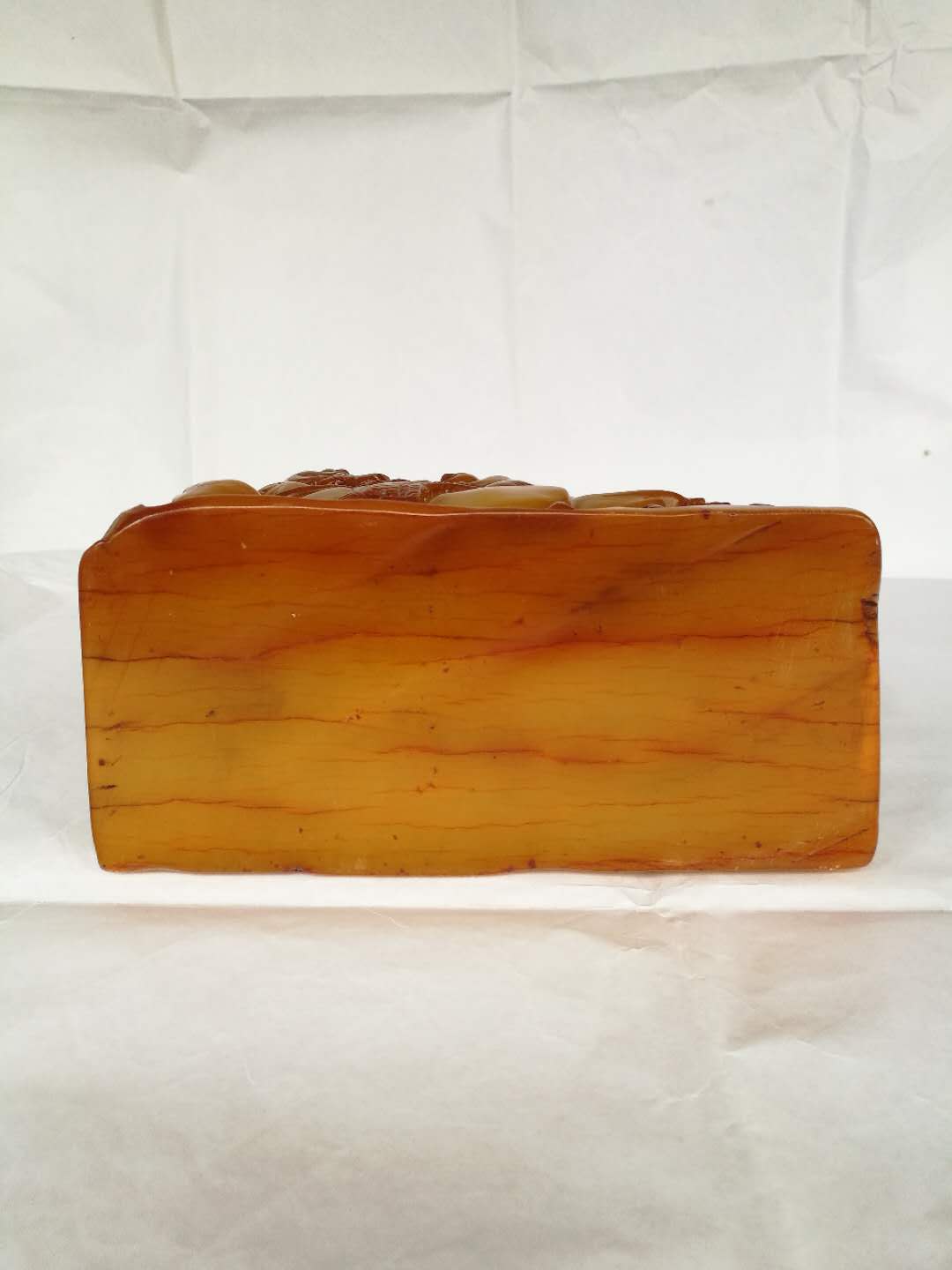
石中之王田黄石,产于福建福州市北郊寿山村田坑的田黄石,是寿山石中的珍品。有着“福”(福建)、“寿”(寿山)、“田”(财富)、“黄”(皇帝专用色)之寓意,故被人们称之为“帝石”。关于田黄石的由来传说它是:女娲补天时遗留在人间的宝石;是凤凰鸟蛋所变……据说还有史书记载:咸丰帝临终时,赐予慈禧一方田黄玉玺,末代皇朝解体,溥仪不要所有珍宝,只将一枚“三连章”缝在棉衣里。这些官方的、民间的传说无疑给田黄石平添了许多神秘的色彩。
The King of Stones, Tianhuangshi, is produced in Tiankeng, Shoushan Village, the northern suburb of Fuzhou City, Fujian Province. It is a treasure of Shoushan Stone. It has the meanings of Fujian, Shoushan, Tian (wealth), Huang (special color for the emperor), so it is called Emperor Stone. The legend about the origin of Tianhuangshi is that it is a gemstone left in the world when Nuwa mended the sky; it is the change of Phoenix eggs... It is said that there are also historical records: when Emperor Xianfeng died, he gave Cixi a Tianhuang jade seal, and the last dynasty collapsed. Puyi didnt want all the treasures, but sewed a three linked seal in the cotton padded clothes. These official and folk legends undoubtedly add a lot of mystery to Tian Huangshiping.
清代历史上,康熙、雍正、乾隆、嘉庆、宣统等皇帝将田黄视同拱壁,把它用于刻制玺印。尤其是乾隆皇帝更有收藏田黄的雅好,一次他在梦中得赐玉皇大帝御笔“福、寿、田”黄色石章,自此每逢元旦祭天时,必在供案中央置一块质地上佳的大田黄,以取吉祥之意。乾隆皇帝一生所拥有的田黄宝玺在清朝历代皇帝中数量最多,如“乾隆御笔”、“信天主人”、“三希堂”等十数个。不仅宫廷,民间也有“一两田黄十两金”之说,质地上乘的田黄往往“易金数倍”。对于田黄的品评,石巢先生在《印石辨》中提出了“温、润、细、结、凝、腻”的“六德”之说。本次华艺国际春拍将推出五方精选的田黄印章,质地工艺上乘,堪称文房类收藏中的顶级首选。
In the history of Qing Dynasty, Emperors Kangxi, Yongzheng, Qianlong, Jiaqing and Xuantong regarded Tianhuang as an arch wall and used it to carve seals. Emperor Qianlong, in particular, had the elegance of collecting Tianhuang. Once in his dream, he was given the yellow stone stamp of Fu, Shou, Tian by the Jade Emperors Royal pen. Since then, when offering sacrifices to the heavens on New Years Day, he must place a piece of Datianhuang with good quality in the center of the confession case for good luck. Emperor Qianlong had the largest number of Tianhuang Baoxi seals in his life, such as Qianlong Imperial Pen, Believing in the Master of Heaven, Sanxitang and so on. Not only the court, but also the people have the saying of one or two fields and twelve gold. The quality of Tianhuang is often several times as easy as gold. For Tian Huangs evaluation, Mr. Shichao put forward the six virtues of warmth, moistening, fineness, coagulation and greasiness in his book Yinshi Bian. This Huayi International Spring Festival Photo will introduce the Tianhuang Seal selected by the Five Parties. It has excellent texture and craftsmanship and can be regarded as the top choice in the collection of literary works.
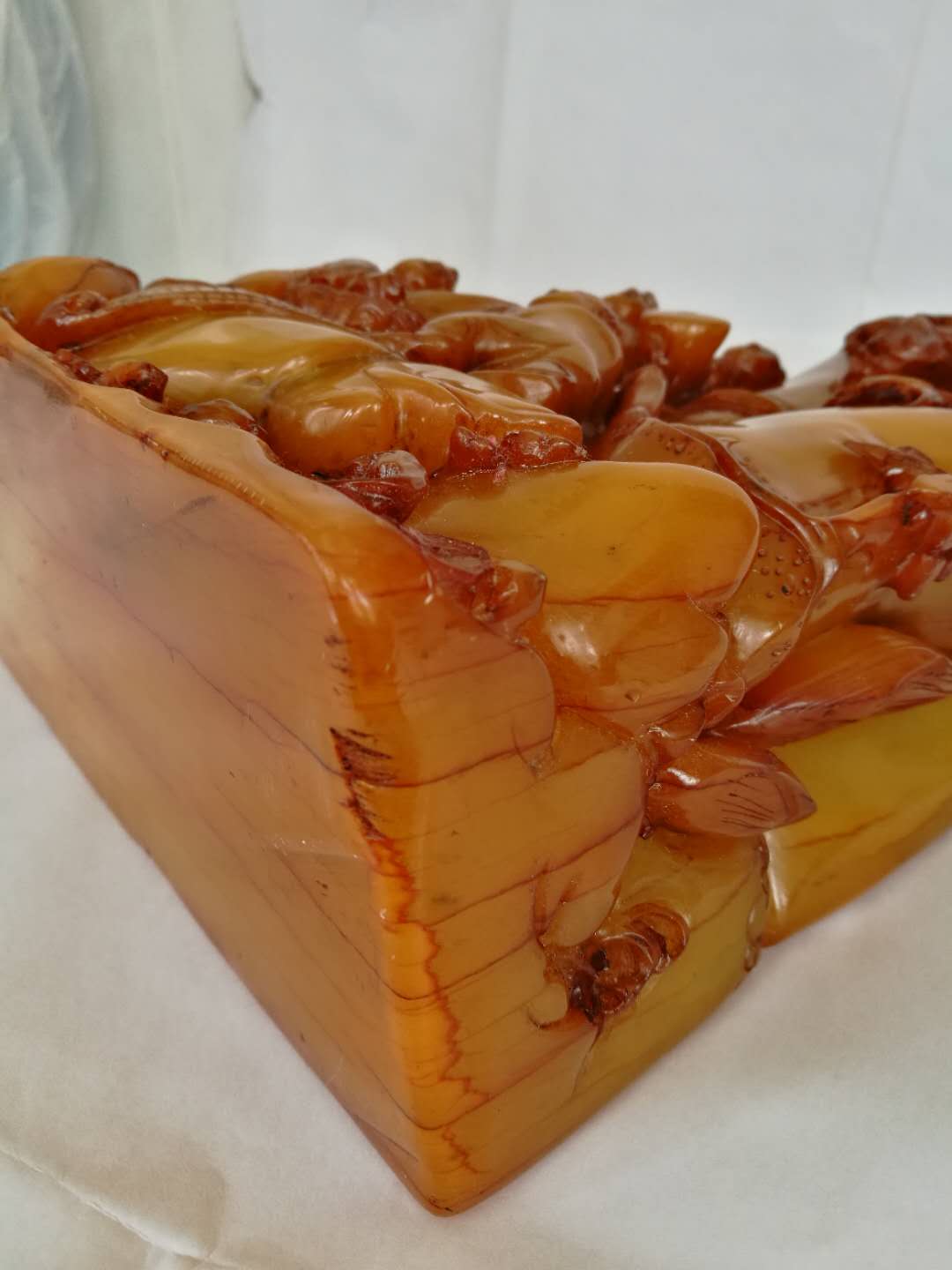
身为“印石三宝”之一的田黄石,呈现黄、白、红、黑等色。具有珍珠光泽、玻璃光泽、油脂光泽,微透明至半透明,少数透明。密度2.50-2.80克/厘米。素有“无纹不成田”、“无皮不成田”、“无格不成田”之称。诚然,从其石质来说,仍以纯净为贵。
Tianhuangshi, one of the three treasures of impression stone, shows yellow, white, red and black colors. With Pearl gloss, glass gloss, grease gloss, transparent to translucent, a few transparent. Density is 2.50-2.80 g/cm. It is known as no grain, no field, no skin, no field, no field without qualifications. It is true that its stone quality is still prized by purity.
田黄石自从由母矿中分裂出来再埋藏到田间,其间历经了数百万年之久,在特殊的环境和特殊条件下,田黄石逐渐地改变了它原来的形态、色彩和质地,出现了其独具的外观特征。归纳起来主要表现石形、石质、石色、石皮以及萝卜纹、红筋等六个方面,可依此来鉴定。
Tianhuangshi has been separated from the mother ore and buried in the field for millions of years. Under the special environment and special conditions, tianhuangshi has gradually changed its original shape, color and texture, showing its unique appearance characteristics. It can be concluded that there are six aspects of stone shape, stone quality, stone color, stone skin, radish grain, red tendon and so on.

石形:田黄石的外形多呈卵石状,光嫩圆滑,没有明显的棱角。这是由于矿块在迁移滚动过程中,受到溪水不断冲刷研磨的结果。
Stone shape: the appearance of Tianhuang stone is mostly pebble shape, smooth and smooth, without obvious edges and corners. This is due to the fact that the ore block is scoured and grinded by the stream during the process of migration and rolling.
石质:田黄石的质地湿润可爱,为微透明或半透明体,状如蛤肉,色似枇杷。如果仔细观察,会焕发出一种其它石材品种所不具备的迷人光彩。
Stone quality: the texture of Tian Huangshi is moist and lovely. It is slightly transparent or translucent. It looks like clam meat and loquat. If carefully observed, it will glow with a charming luster that other stone varieties do not have.
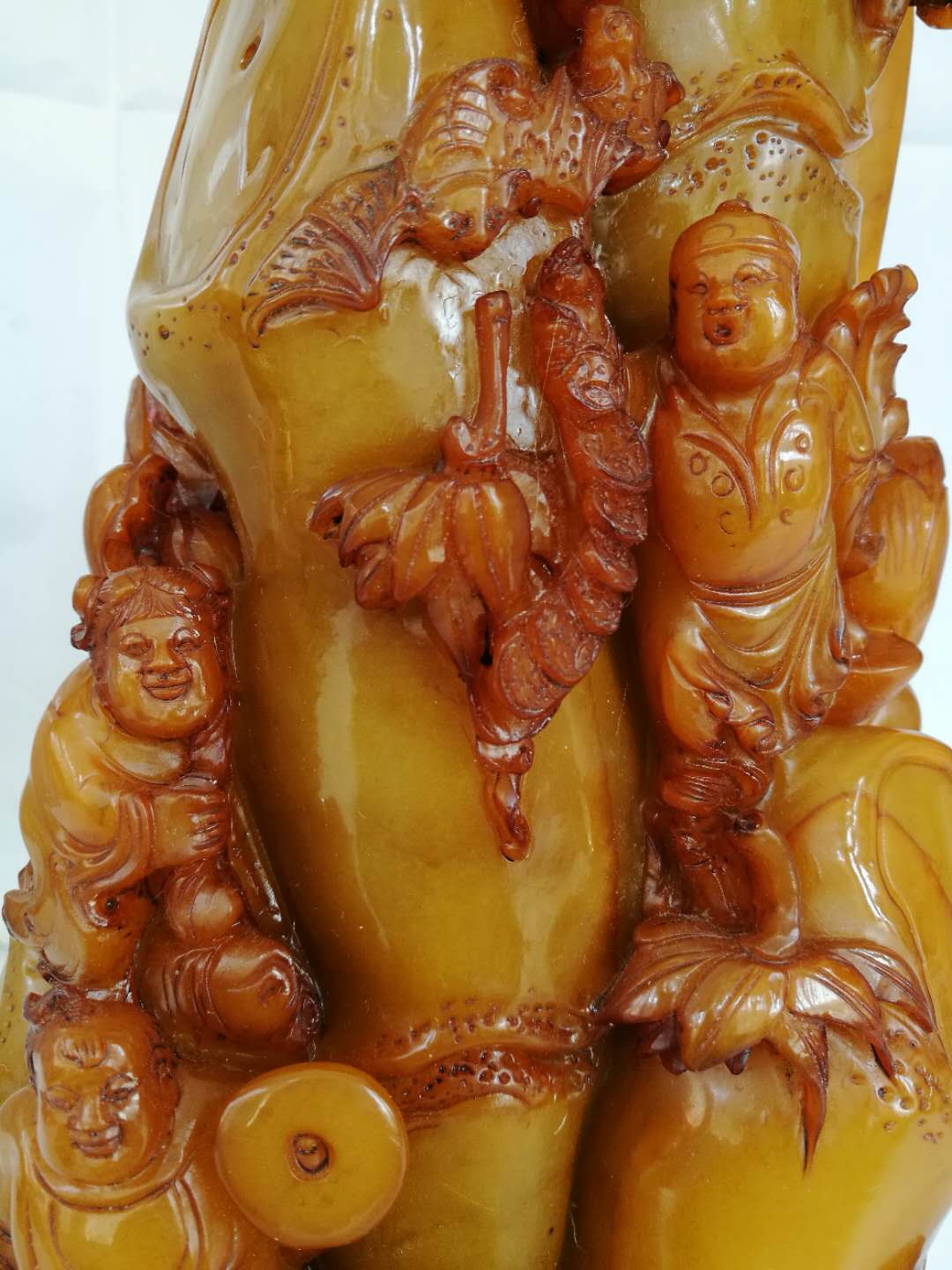
石色:“田黄石”顾名思义,是一种黄颜色的宝石。尽管按照色相来区分,有田黄、白田、红田、黑田以及银裹金、金裹银等品种,但无论什么色彩的田黄石都是以黄色作为它的基调,只不过偏白、偏红或偏黑而已。比如“红田石”其色近橙黄如桔皮,绝不可能出现桃红、朱红和血红的色彩;“黑田石”则黑中带赭;即使被称作“白田”的田黄石,也并非纯白如雪,而是白中稍带淡黄或蛋清色。
there are varieties of Tianhuang, Baitian, Hongtian, Heitian, silver wrapped gold, gold wrapped silver and so on according to the hue, no matter what the color of Tianhuang stone is, it takes yellow as its keynote, only partial white, partial red or partial black. For example, the color of Hongtian stone is close to orange yellow, such as orange peel, and it is impossible to have the color of peach red, vermilion and blood red; Heitian stone is black with ochre; even the Baitian Tianhuang stone is not pure white like snow, but white with light yellow or egg white.
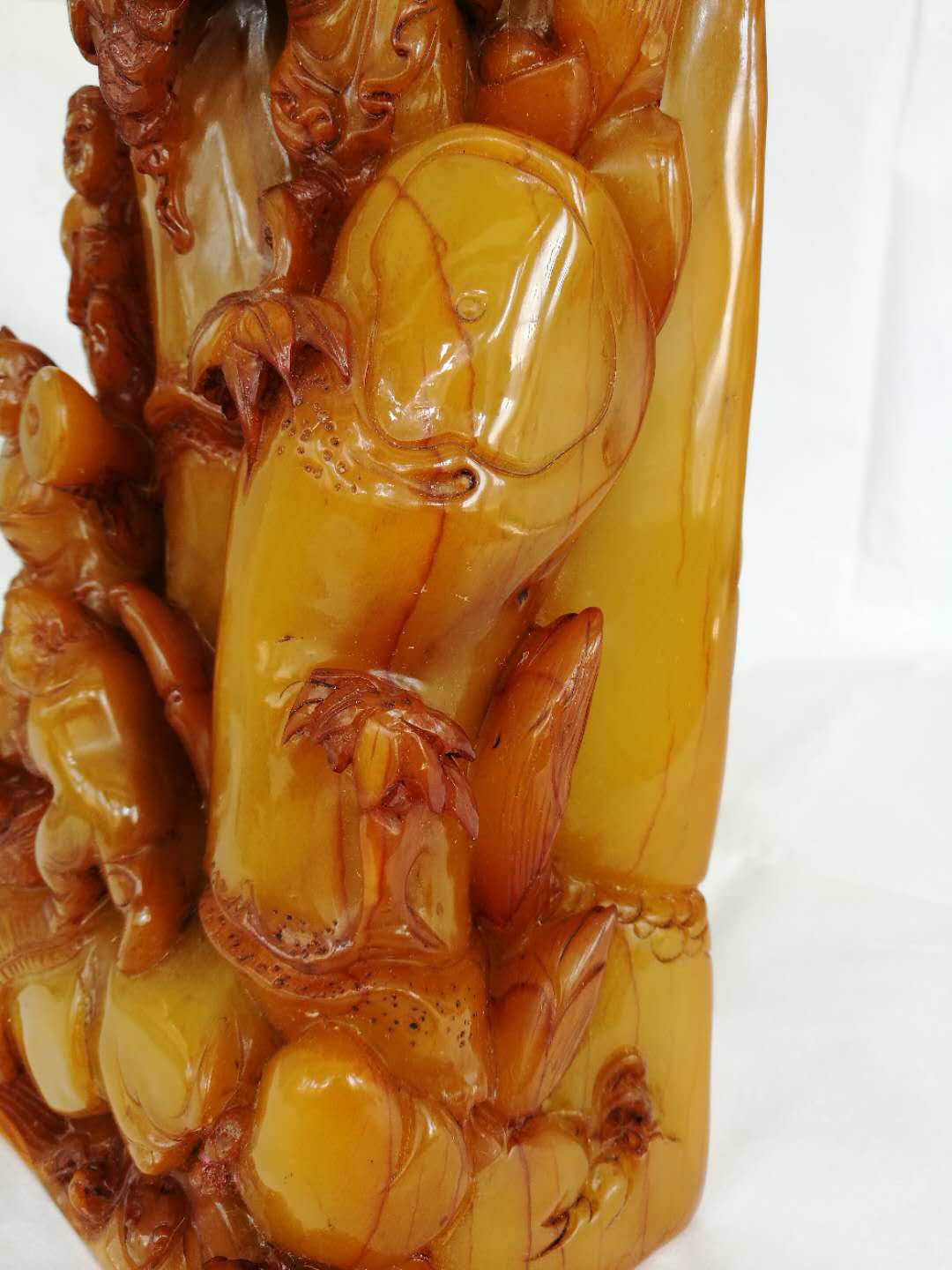
石皮:多数田黄石的外表都有黄色或黑色的皮层包裹着,或厚或薄,或全裹,或稀疏挂皮,形态变幻无常,虽然也有一些田黄石因为色皮极薄,一经雕刻打磨即被清除,但田黄石的颜色都不是表里如一的,通常是由表皮向里层逐渐转淡,乃至泛白。这种色彩的变化规律,块头大的田黄石尤为明显。
Stone skin: most of the surface of Tianhuang stone is covered with yellow or black cortex, thick or thin, or full, or sparse hanging skin, and its shape is changeable. Although some of them are removed as soon as they are carved and polished because of their extremely thin skin, the color of Tianhuang stone is not the same on the surface, but it is usually gradually reduced from the epidermis to the inner layer, or even whitened. The change rule of this kind of color is especially obvious for the large tianhuangshi.
萝卜纹:凡是透明度较强的田黄石,在强烈的光线下观察,它的肌理往往隐约可见到一条条细而密的纹理,其形状犹如刚刚出土的白萝卜纤维,故有“萝卜纹”之称。
Radish pattern: the texture of tianhuangshi, which has strong transparency, can be seen in a thin and dense texture under strong light. Its shape is like the white radish fiber just unearthed, so it is called radish pattern.
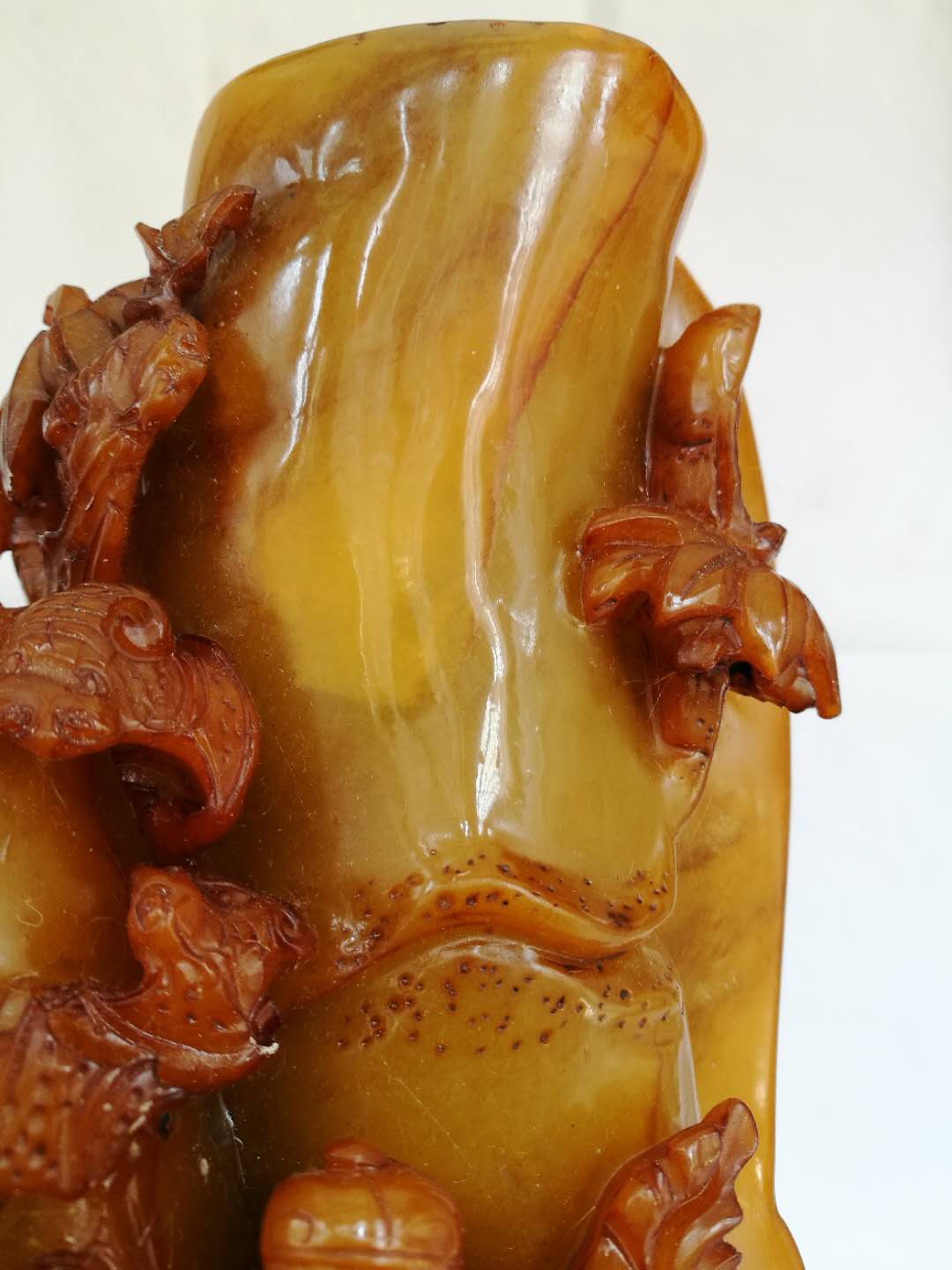
红筋:红筋是指田黄石表层偶尔出现的红色筋络,红如血,细如丝,俗称“红筋”又叫“血丝”。它是田黄石在迁移过程中产生的细裂纹,经土壤中氧化铁渗透而形成的格纹。
田黄石的真伪鉴定,主要是依靠肉眼进行,还可以根据上述外观特征基本可以辨别清楚。
Red tendon: Red tendon refers to the red tendon occasionally appearing on the surface of Tian Huangshi, which is red as blood and thin as silk, commonly known as red tendon or blood silk. It is a kind of grid pattern formed by the fine crack produced during the migration of tianhuangshi and the infiltration of iron oxide in the soil.
The identification of the authenticity of tianhuangshi mainly depends on the naked eye, and can be basically distinguished according to the above appearance characteristics.
田黄石之所以珍稀的另一个原因是因为在地球上,只有福建寿山村一条小溪两旁数里狭长的水田底下砂层才有。且经过数百年来的连续掘采,寿山村的水田已被翻掘了无数次,如今已开采殆尽,上乘的田黄早已是无价之宝。古时即有“一两田黄三两金”之说,而今已该是“两”对“斤”了,故田黄的价格涨势迅猛。
Another reason why Tianhuangshi is rare is that on earth, only the sandy layer beneath the paddy field, which is several miles long and narrow on both sides of a stream in Shoushan Village, Fujian Province, exists. And after hundreds of years of continuous excavation and mining, Shoushan village paddy fields have been excavated countless times, and now have been exploited, excellent Tianhuang has long been priceless. In ancient times, there was the saying of one or two fields, three or two gold, but now it should be two to jin, so the price of Tianhuang has risen rapidly.

专家推荐:田黄石是寿山石系中的瑰宝,素有“万石中之王”尊号。其色泽温润可爱,肌理细密,自明清以来就被印人视为“印石之王”。数百年来田黄石极受 藏家至爱,正如俗语所说:“黄金易得,田黄难求”。早在一千多年前,我国已有人开始采集,到了明清两代田黄石更是盛名于世。许多达官显贵, 文人雅士竞相刻意收集田黄石。相传清初时期皇帝祭天,神案上都少不了一方上品田黄石。因此,田黄石一直盛名不衰,身价倍增,曾有古话“一两 田黄一两金”。从图片来看萝卜丝纹体现的比较明显,而且有一定的年代特征。质地致密、细腻、温润、光洁。尤为引人注目的是其肌里隐约可见萝 卜纹状细纹,具有油脂光泽。此摆件石质温润,色彩明艳,六德兼备,造型方正、棱角分明,布局妥贴、运刀技 法炉火纯青,精微处纤毫必爽,圆润处 似行云流水,刀法、刀味皆有古韵,不同凡响,田石肌理清晰,石质润透凝腻,萝卜纹清晰密集,颜色滢黄, 凝脂似玉,盈润剔透。刀笔清俊,印体 大气,印文雅健流利,遒劲精美,品相完整,实为难得一见之田黄珍品,此摆件保存完好,材质珍贵,雕刻工艺 精细,实属难得,值得收藏。
Expert recommendation: tianhuangshi is a gem in Shoushan stone series, known as king of ten thousand stones. Its color is warm and lovely, and its texture is fine. Since the Ming and Qing Dynasties, it has been regarded as the king of stone. For hundreds of years, Tianhuang stone has been loved by collectors. As the saying goes, gold is easy to get, but Tianhuang is hard to get.. As early as more than a thousand years ago, people began to collect in China. By the Ming and Qing Dynasties, Tian Huangshi was even more famous. Many dignitaries and scholars competed to collect tianhuangshi. It is said that in the early Qing Dynasty, when the emperor offered sacrifices to the heaven, there was no lack of top grade Tian Huangshi. Therefore, Tianhuang stone has always been famous and has double value. There was an old saying one or two Tianhuang and one or two gold. From the picture, it can be seen that the radish silk pattern is obvious and has certain age characteristics. The texture is dense, delicate, warm and smooth. What is particularly striking is that there are some radish like fine lines in its muscles, which have grease luster. This ornament is of warm stone, bright color, six virtues, square shape, clear edges and corners, proper layout, perfect knife handling technique, delicate place, smooth place like running clouds and flowing water, knife technique and knife taste are of ancient charm, extraordinary, clear texture of field stone, moist and thick stone, clear and dense radish grain, bright yellow color, condensed fat like jade, moist and clear. It is a rare treasure of Tianhuang, which is well preserved, precious in material and fine in carving process. It is worth collecting.
版权声明:CosMeDna所有作品(图文、音视频)均由用户自行上传分享,仅供网友学习交流。若您的权利被侵害,请联系删除!
本文链接://www.cosmedna.com/article/191933388.html




